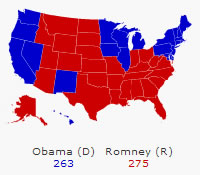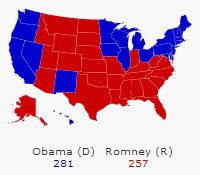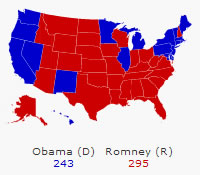Just over two weeks ago, I began moving my presidential electoral projection toward a more ‘complete’ (though volatile) picture. As I said at the time, rather than erring on the side of stability, I began erring instead on the side of completeness. When I made the switch, incumbent President Barack Obama (D) was narrowly ahead of former Governor Mitt Romney (R-MA) in the electoral college vote with a 253-248 margin, with 37 electors still ‘up for grabs.’
My hope had been that by today—one day before the election—I would have a complete electoral prediction, but my analysis of the race still has a number of major uncertainties. Based solely on state-by-state polling data, it would seem that Obama is very slightly ahead in the electoral college (though, based on national polls, it would seem that he is slightly behind in the popular vote—a purely academic observation since we do not elect presidents by popular vote). However, there is some reason to believe that some state polls—especially in Ohio—are skewed in Obama’s favor due to sampling irregularities. I doubt this skew is nearly as large as some Republican pundits seem to believe, but there are good reasons to believe that Romney is actually doing better in Ohio than the polls indicate—perhaps by one or two percentage points.
I feel fairly comfortable with the other state-by-state polls, so it is most likely that this will be a very close election, and that the winner will be whichever candidate wins Ohio. Contrary to what some media outlets are reporting, I doubt that Michigan (Obama), Missouri (Romney), North Carolina (Romney), or Pennsylvania (Obama) were ever really competitive. That leaves Colorado, Florida, Iowa, Nevada, New Hampshire, Ohio, and Wisconsin as the serious swing states. Romney is likely to win Colorado, Florida, and Virginia. Obama is likely to win Iowa, Nevada, and Wisconsin. New Hampshire and the aforementioned Ohio are the hardest to predict.
With all of this in mind, I see three plausible scenarios for the election outcome.
Scenario 1: Narrow Romney Win
 If I had to pick one electoral scenario as my ‘official prediction,’ this would be it. Among the ‘real’ swing states, Obama wins Iowa, New Hampshire, Nevada, and Wisconsin. Romney wins Colorado, Florida, Ohio, and Virginia. This gives Romney a perilously narrow win with 275 electoral votes to Obama’s 263.
If I had to pick one electoral scenario as my ‘official prediction,’ this would be it. Among the ‘real’ swing states, Obama wins Iowa, New Hampshire, Nevada, and Wisconsin. Romney wins Colorado, Florida, Ohio, and Virginia. This gives Romney a perilously narrow win with 275 electoral votes to Obama’s 263.
There are, however, a number of uncertainties with this scenario. If Obama pulls out a win in any of the swing states I’ve assigned to Romney, it will move the election in the incumbent’s favor. Romney could also win New Hampshire—where an Obama victory is certainly not assured. If Romney won New Hampshire, but lost Colorado, he would still win with the absolute bare-minimum of 270 electors.
My feeling is that the Ohio poll skew is significant enough to give Romney a narrow win there, so I consider this scenario to be the most likely outcome . . . but not by much.
If Ohio does indeed go for Mitt Romney, he likely wins the election with at least 270 votes, but probably no more than 280.
Scenario 2: Narrow Obama Win
 Although I think the Ohio polls are skewed in Obama’s favor, there’s a distinct possibility that I’m wrong, or that the skew is smaller than I suspect. It is certainly possible that Ohio does not break for the challenger, but narrowly supports the incumbent.
Although I think the Ohio polls are skewed in Obama’s favor, there’s a distinct possibility that I’m wrong, or that the skew is smaller than I suspect. It is certainly possible that Ohio does not break for the challenger, but narrowly supports the incumbent.
Using the same assumptions from my first scenario, but moving Ohio to the Obama column, gives President Obama a narrow win with 281 electoral votes to Romney’s 257.
If Romney was able to win New Hampshire that would narrow the margin, but Obama would still win with 277 electors. Adding a surprise Romney victory in Wisconsin would turn the election in his favor with a razor-thin 271 elector majority, but that’s quite unlikely.
Notably, if we start with this scenario but give Romney surprise wins in Iowa and Nevada, we end up with an exact 269-269 tie, which would throw the election to the House of Representatives under an odd ‘one vote per state’ system (which, according to a analysis by Kyle Kondik at Sabato’s Crystal Ball, would almost certainly give the election to Romney).
If Ohio goes for Obama, he will likely win with at least 270 votes, and possibly as many as 290 if he gets Colorado as well.
Scenario 3: Romney Landslide
 I see little indication that there is a significant state poll skew in Obama’s favor outside of Ohio. But many of the swing states show the two candidates very, very close, so even a relatively small skew across-the-board could mean that the race is very different than it seems.
I see little indication that there is a significant state poll skew in Obama’s favor outside of Ohio. But many of the swing states show the two candidates very, very close, so even a relatively small skew across-the-board could mean that the race is very different than it seems.
I would be very, very surprised if Romney wins Pennsylvania, Michigan, or Nevada. Obama polls comfortably ahead in those states, enough that even if they are skewed it likely isn’t enough to change the result. But Iowa, New Hampshire, and Wisconsin are closer, and perhaps more prone to skewing. Starting with my first scenario and moving these three states to the Romney column gives the challenger a solid 295 elector win.
Consider that late undecided voters—who still make up two or three percent of the electorate in most state polls—tend to break for the challenger, and combine that with the stronger enthusiasm on the Republican side in this election cycle and the waning of Obama’s support among college students and moderates. With this in mind, a hard swing for Romney in the final hours of the election is not beyond the realm of possibility . . . although I do consider it unlikely.
If a late swing for Romney materializes, he likely wins with at least 279 votes, and may even manage as many as 301.
The Final Word (Until the Results Come In)
So how do I weight the three likely outcomes?
I give the first scenario, where Romney wins narrowly, a forty-five percent chance. I give the second scenario, where Obama wins narrowly, a forty percent chance. I give the third scenario, where Romney wins handily, a fifteen percent chance.
All-in-all, that adds up to a sixty percent chance that Romney wins, and a forty percent chance that Obama is reelected. In other words, my analysis lines up pretty closely with the polls: the race is very, very close, and could really go either way.
Be sure to check in with Off on a Tangent’s live election coverage, which begins before 7:00 p.m. on election night.
